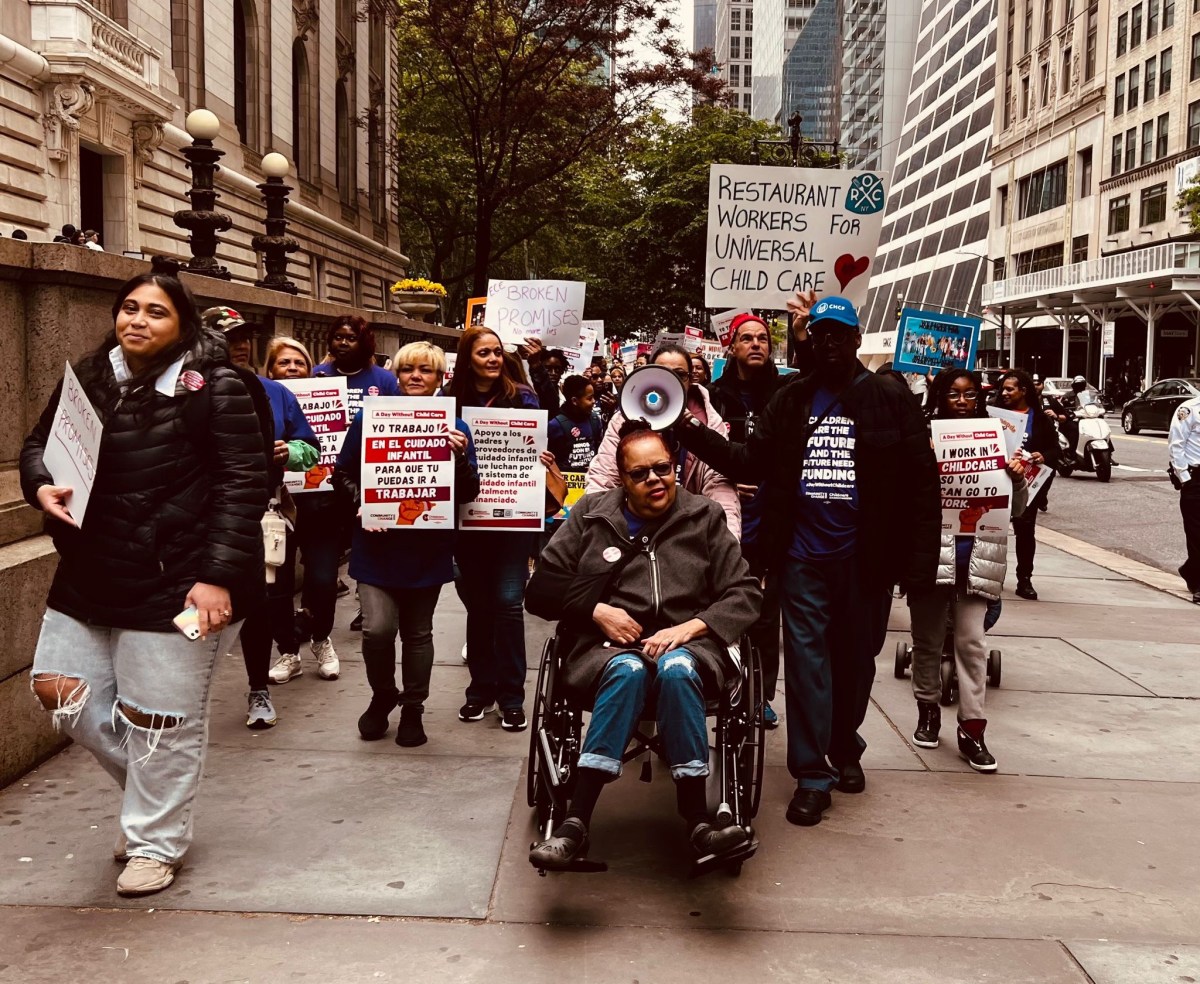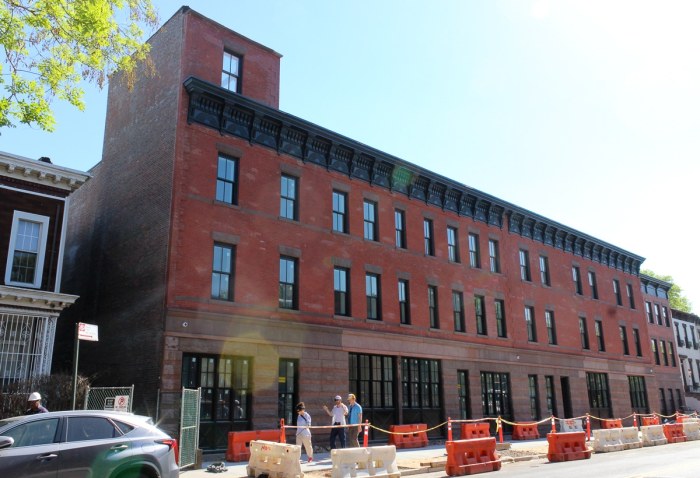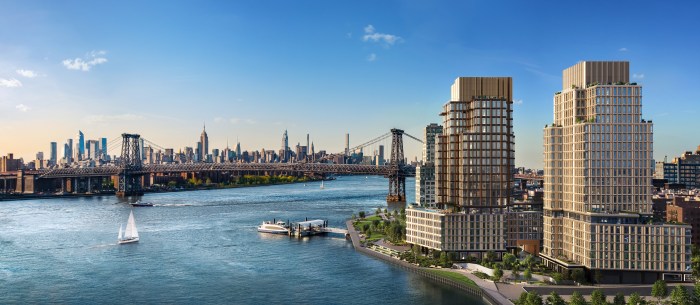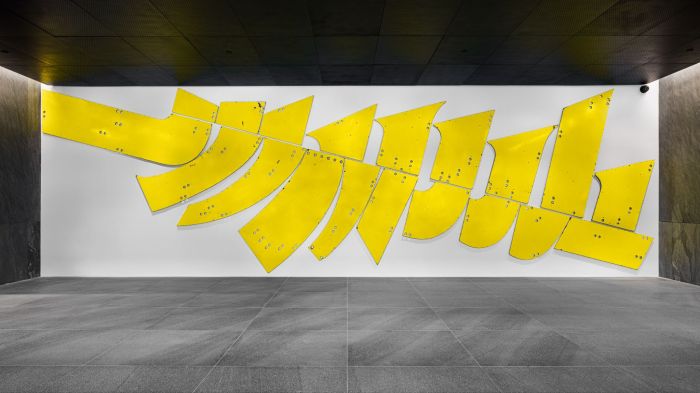The same day they signed a widely publicized agreement setting aside land
for developer Bruce Ratner’s proposed Atlantic Yards project, top
officials of the Pataki and Bloomberg administrations signed a separate
pact with the developer, granting him the right to build up adjacent urban
renewal sites without city review.
That second agreement was never made public, but it turned up this week
in the state’s response to a fairly broad Freedom of Information
Act request made by a neighborhood group opposed to the Atlantic Yards
plan.
The document stipulates that Ratner would be able to obtain the development
rights to build nearly 1.9 million square feet of residential and commercial
space on properties north and west of the Atlantic Avenue rail yards,
exceeding the current zoning for those sites, without having to put the
proposal through the city’s lengthy land use review process. That
review requires public hearings before the community board, borough president,
City Planning Commission and City Council. The developer currently operates
the Atlantic Center mall and leases space to a Modell’s sporting
goods store on those potential development sites. The Modell’s block
also contains a PC Richard & Son electronics store. Ratner is currently
negotitaing with the state-controlled Metropolitan Transportation Authority
to build over the Long Island Rail Road storage yards across the street
to build a professional basketball arena as part of the Atlantic Yards
plan. Should he fail to work out a deal for that property, the second
MOU stipulates, Ratner could still build on the two new sites, but would
have to either abide by current zoning or gain city approval to surpass
it.
Ratner’s interest in expanding his plan to include the block bounded
by Pacific Street and Flatbush, Fourth and Atlantic avenues, was first
revealed in a June 4 article in The Brooklyn Papers based on comments
made by Forest City Ratner Executive Vice President James Stuckey. At
a May 26 City Council hearing, Stuckey cited the expansion into Park Slope
as a way to increase the amount of housing in the Atlantic Yards plan.
But no mention was made of the deal for the site already signed by the
city and state’s top development officials.
Develop-Don’t Destroy Brooklyn — a neighborhood group that opposes
Ratner’s plan to build a professional basketball arena and a 17-tower
housing, office space and commercial complex over six blocks of Prospect
Heights emanating from Flatbush and Atlantic avenues — made copies
of the agreement obtained in its request available to the public on Wednesday.
The second agreement, also signed on Feb. 18, makes the Empire State Development
Corporation (ESDC) the lead agency for development in the “Atlantic
Terminal Urban Renewal Area” — allowing for the use of eminent
domain condemnation of property and taking review of any zoning changes
or transfers of unused development rights out of the city’s hands,
much the same way as does the MOU for Ratner’s Atlantic Yards plan.
None of the property referenced in the second MOU is owned by the state.
Both MOUs were signed by Deputy Mayor for Economic Development and Rebuilding
Daniel Doctoroff, ESDC Chairman and CEO Charles Gargano, Ratner, and city
Economic Development Corporation President Andrew Alper, but only the
Atlantic Yards agreement was made public, in press releases issued by
Mayor Michael Bloomberg and the EDC.
“Basically [the second MOU] says if the arena project is passed,
[Ratner] can develop over those sites, and the [Atlantic Center] mall,
and these two pieces of property don’t have to go through [city review],”
said Daniel Goldstein, a spokesman for DDDB.
“Why was this not released when the other one was? Why has this document
not been made public?” Goldstein asked.
In laying out the parameters of the MOU, the document states: “The
project shall mean the design, development and construction of a mixed-use
development consisting of residential development, commercial office space,
and retail space … using the unused development rights attributable
to … Atlantic Center (including the rights attributable to the demapped
portion of Fort Greene Place) which [the parties] believe consist of approximately
1.586 million zoning square feet … and Site 5, consisting of approximately
308,000 zoning square feet …”
The MOU also references an earlier pact for the sites, signed on May 17,
2004, suggesting the city and state intended to commit the development
rights to Ratner long before support for Atlantic Yards was certain.
The document was obtained by Develop-Don’t Destroy Brooklyn after
they submitted a freedom of information request to the ESDC, asking how
Ratner’s Forest City Ratner Companies was chosen as the developer
of the Atlantic Terminal Urban Renewal Area (ATURA), which encompasses
parts of Downtown Brooklyn, Prospect Heights and Park Slope.
The project’s footprint would then encompass, and allow zoning overrides
above, the Atlantic Terminal mall, which contains Target; the Atlantic
Center mall, across Fort Greene Place, where Old Navy and Pathmark are
located; provide for additional development above Fort Greene Place, across
which an enclosed pedestrian bridge connects the two Ratner malls; and
include the entire block that holds a single-story PC Richards appliance
store and Modell’s athletic goods store, bounded by Pacific Street
and Fourth, Flatbush and Atlantic avenues.
The latter block would also be subject to eminent domain condemnation,
allowing Forest City Ratner to take property currently owned by PC Richard,
which has not yet agreed to sell its portion of Site 5.
In a press release sent out to their e-mail list, DDDB provided a link
to copies of both MOUs online.
“The whole Ratner deal has moved forward over the past two years
in backrooms and with great secrecy,” Goldstein said.
“This unreleased second MOU raises serious questions about the developer’s
honesty,” he added, as well as that of the city and state agencies
involved.
A mayoral spokesman declined to comment and the ESDC referred all questions
to the city.
“We do not distribute MOUs, but this one’s been available to
anyone that requested it,” said Janel Patterson, a spokeswoman for
the city EDC.
Asked how anyone could have possibly known of its existence, and why the
one MOU was widely publicized while the other was never mentioned, she
declined to comment.
Prospect Heights-Fort Greene Councilwoman Letitia James, a staunch opponent
of Ratner’s Atlantic Yards plan, said she had heard nothing about
the second MOU before DDDB released its finding this week.
“I knew nothing about this,” she said on Wednesday. “This
is just another attempt by the [Bloomberg] administration to expand Forest
City Ratner’s monopoly on Downtown Brooklyn.”
Patterson defended the choice of Ratner as the developer for the sites,
saying, “We’ve been talking to FCR about his project for some
time. We’re simply designating a developer to implement parts of
the original urban renewal plan.”
James argued that the city’s negotiations with Ratner amounted to
“sole sourcing,” handing deals to favored developers.
“Publicly, they have told me repeatedly that they will not do sole
sourcing,” James said. “I say, if they’re against sole
sourcing, then why doesn’t that same rule apply to Forest City Ratner?”
The councilwoman contends that the city should have put the property out
for bid.
A Forest City Ratner spokesman said plans for Site 5 had already been
made public.
“The proposed development at Site 5 should not come as a surprise
to anyone,” said Forest City Ratner spokesman Joe DePlasco. “In
fact, it was part of a May presentation to the City Council, included
in many other discussions and presentations.
“While not technically part of the Atlantic Yards development, it
was included in these presentations because development there would, of
course, be in close proximity to the larger project.”

















